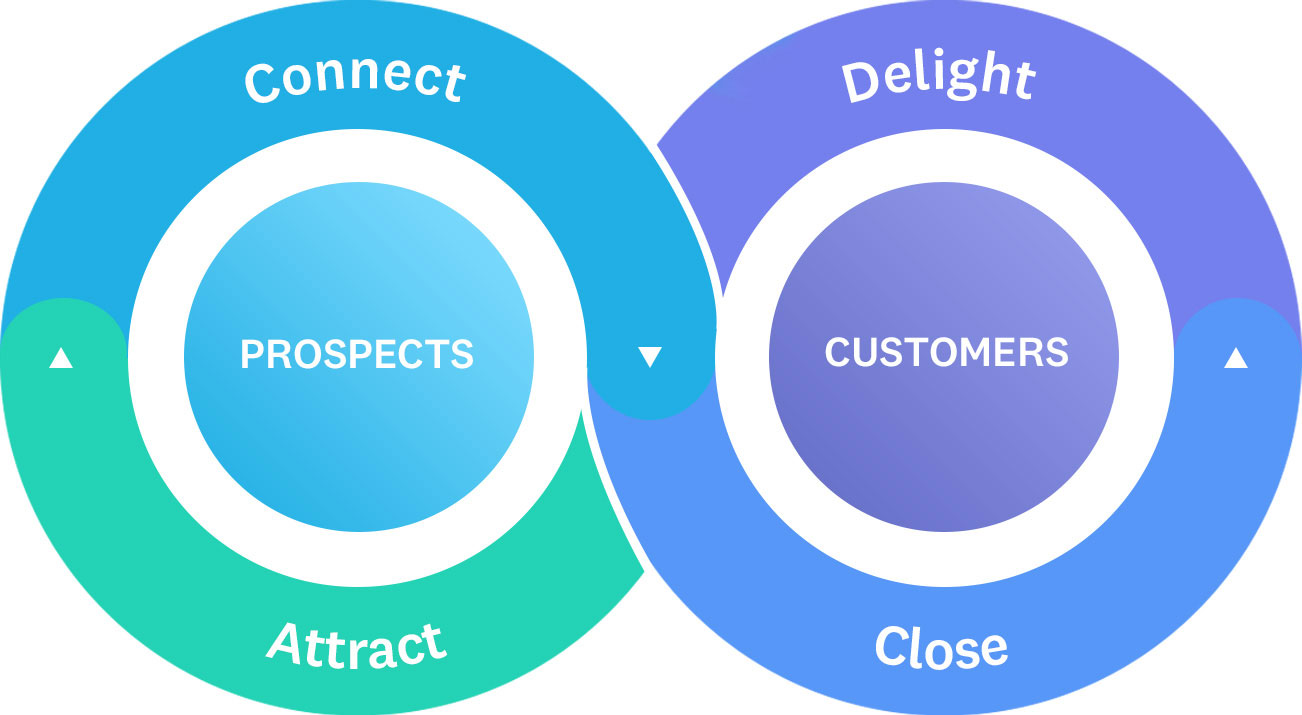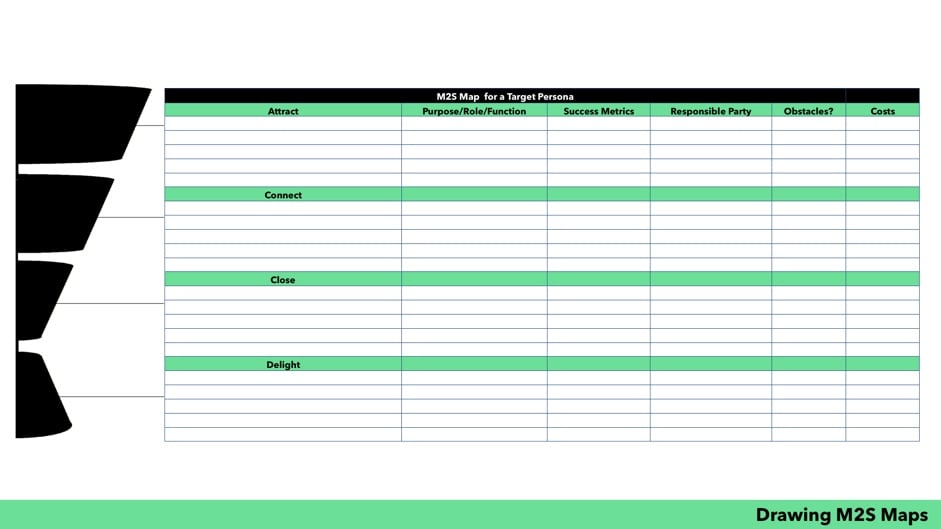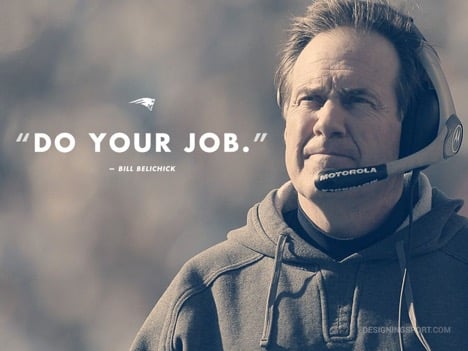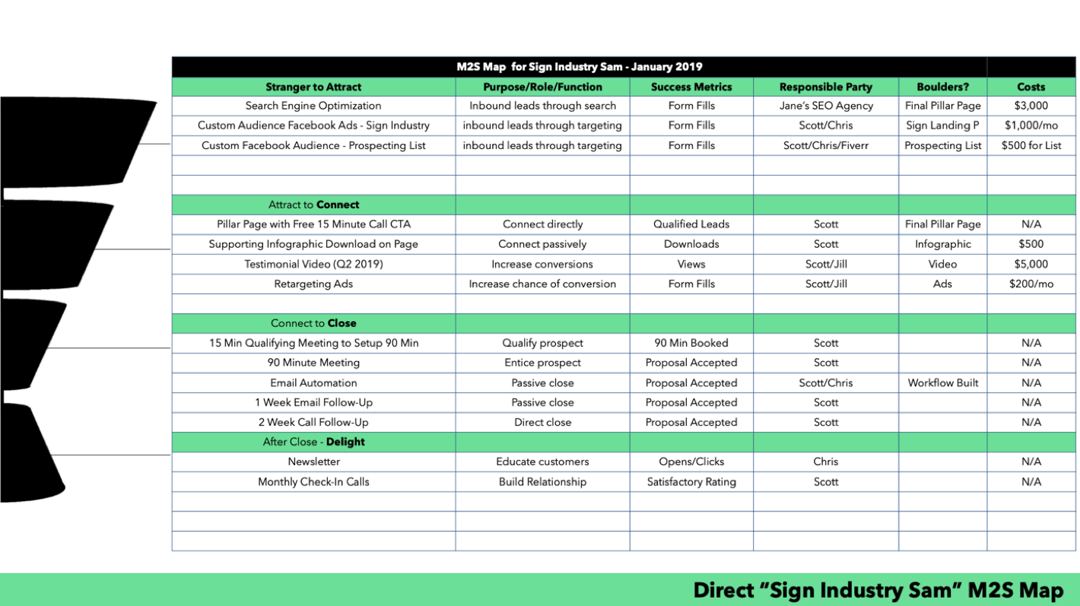
Purposeful Marketing Method: Drawing Your Marketing to Sales (M2S) Maps
By Austin LaRoche, ATAK Interactive CEO
Let’s go back to the central theme of the Purposeful Marketing Method:
Ensuring that every marketing dollar a business spends, every action it takes, and every plan it lays out serves the purpose of growing.
This is where all the “whys” you have built turns into “how.” This is the game plan before the Super Bowl. The blueprint before breaking ground. The map before the hitting the trail.
We draw Marketing to Sales Maps to tie in all of the work that has been done to this point and all the work that will come after.
Before you get to Drawing the M2S Maps in the Purposeful Marketing Method, a lot have decisions have been made. As a company, you have decided:
- How to communicate the paragraph that sells your business
- How to communicate your business in 7 words or less
- The most valuable aspects of your company and how they bring value
- Your top collateral needs
- Your company’s cohesive style direction
- Your Leadership Message to attract
- Your connect-to-close process, the Vision Pitch
- Your 3 Target Personas to market to
- The 5 (or less) ways you acquire customers
- The 5 (or less) revenue streams you have
- The Most Important Metrics to your growth
- What your current data is telling you
- What you think we need to hit our goals, in resources and in money
- What resources you need to fill
It’s time to take all of these decisions we’ve made and put them into a true plan of action.
What is an M2S Map?
Our M2S Maps simply take the Customer Lifecycle and build granular “Plans of Action” for each step in the process. We create one map per Target Persona and identify how we will Attract, Connect, Close, and Delight the persona. Additionally, we identify who will be responsible, how much we will spend on the action, and the success metrics each action feeds into.
Take a look at the sample below and download it here:

The Rules of Drawing M2S Maps
Before we break each section down and provide an example for one of our Target Persona examples we’ve used in the past, let’s go over a few ground rules for drawing maps:
- Be as specific as possible. As you will see in the upcoming breakdown, this needs to be considered at each step.
- Be as realistic as possible. While we encourage businesses to be ambitious and start with a wide net, let’s not dream beyond what’s possible.
- Make sure you can manage this process. Remember that you’re drawing three of these and keep your “capacity” top of mind.
- Consider all of the work you’ve put in thus far. Insert your Vision Pitch into the process. Review your Budget and Resources Audit and your Visual Identity Assessment. This is meant to be the culmination of all of your work within the Method thus far.
The Customer Lifecycle
The first part of drawing the map is to identify how we will Attract, Connect, Close, and Delight this persona. There are multiple opportunities at each stage of the Lifecycle – both outbound and inbound – for your company to engage in. I doubt you need another reminder at this point, but in case you need one more pep talk, remember, nobody knows your business and industry as well as you do! Don’t get lost in chasing new shiny technologies and communication platforms if they don’t work for your operation. For instance, if you sell machines, chances are, you’re not going to attract new prospects using social media, especially platforms like Instagram and Snapchat. That’s not to say you shouldn’t delight your current customers by posting great content on LinkedIn, it’s just setting a realistic expectation for WHY you are using the tool.
Okay, you know your business. You’ve put the groundwork in. Now let’s make a map!
Attract: How we make our target audience aware of our existence
Businesses can’t hide and grow. If you want to fish, you need to go where the fish are.
How you get “out there” needs to be strategic, cost-effective, and needs to provide you with the best chance to get your prospect to take action towards connecting. Keep this in mind, as companies waste millions of dollars each year chasing “brand awareness.” Marketers love brand awareness because it’s an ambiguous term and easy to manipulate. Your boss or client will only buy your “successful brand awareness campaign” for so long before the conversions need to back up the story you’re telling, so attract wisely.
When it comes to the types of Attraction tactics a company can utilize, a good way to start is to delineate between inbound and outbound activities.
Note that the actions above are simply starting points to get your mind started thinking the right way. When drawing your maps, you need to get far more specific.
One important element for the Attraction phase, is the creative that’s used to Attract.
For instance, we indicate above that this specific company wants to do Direct Advertising by “running 1 ad every month in our 3 largest industry publications.” This is probably a great way to attract Target Personas, but inside of this desire is a barrier – we must first have an ad campaign, creative for the campaign, etc. Some of this work was done during Brand Day, so you are at least on the right path, but ideas are only as good as their execution, and you will need to get the new creative direction implemented before hitting the ground running.
This is where Obstacles come back into play. We will explore these further in a section below, but it’s important to think about when you’re creating these maps. If you try to build Camelot but it takes you 2 years to get there, it defeats the purpose of the Method. As you go through and decide how you want to Attract, Connect, Close, and Delight your prospects and customers, be realistic about what Obstacles exist and how difficult and timely they may or may not be to overcome.
Connect: How we convert strangers to prospects
As we alluded to above, anyone can just build awareness if they have a budget. But the point of attraction in the customer lifecycle is to get to the point of connection. Throwing your logo and tagline on a billboard is easy. But it means nothing if that attraction isn’t enticing your prospects to take action to connect.
This is where we work hard to get our first conversion – from stranger to opportunity – and we need to do everything we can to increase our chances of convincing our target to “take the leap” and see what we are all about.
One of the key factors here is to provide educational content and follow the “teach, don’t sell” mindset. Sales will be a byproduct of good teaching and providing true value to the prospect, whether they choose to go with you or not.
So what tactics can be deployed in the “Connect” phase? These vary, and unlike the “Attract” phase where a delineation between inbound and outbound was needed, the connect phase is more unified on that front.
Whether you send a cold email, meet someone at a trade show, or earn a click-through a Google search, you still need to have consistent content and messaging built to persuade them to take the next action. Think of the “Connect” phase as your opportunity to provide value through education. It can be interactive, it can be printed, it can be explained verbally, it can be downloaded. Doesn’t matter.
However, there is a delineation that does need to be considered: collateral vs. offers. Collateral is passive. Anyone can see it without providing an email address or other information. These informative pieces are generally considered more basic than offers. Offers are where companies pull out all of the stops and provide prospects with their most enticing pieces and put a gated entry (usually the submission of contact information) to obtain the valuable content.
Content in the collateral section is valuable, but not so rich that a potential prospect would want to give anything up to obtain it. On the flip side, the offers are so valuable that a prospect will take the extra effort to obtain what you’re providing.
Balancing the two is an important part of the Connect phase. You don’t want every item out there to be gated, that would turn off all of your prospects. However, you don’t want prospects all over your site without capturing any data on them, either. You need to develop both types of content for the Connect phase and delineate how often you use them.
Close: How we convert prospects to customers.
Back during Brand Day, we introduced the concept of the Vision Pitch. Remember, the Vision Pitch is the next big step ONCE you have actually connected with the prospect. It is included in the “Close” phase because the absolute intention of the Vision Pitch is to move the prospect down the funnel, all the way to the point of close if possible.
Here’s a reminder on when the Vision Pitch comes into play and why it is so important:
Most B2B companies have a multi-layered process from connect to close. There’s an initial point of contact, a call, or email where the business qualifies the prospect. If they determine the prospect to be a good fit, something further is scheduled. Maybe it’s an in-person “pitch meeting,” maybe a conference call, maybe it’s a demo over screenshare. Regardless of the medium, it’s an invitation to be sold and you want to show up to the party prepared.
That’s why you need the Vision Pitch. The Vision Pitch is an organized visual representation of your company’s proven process. If you’re in software, the VP is usually your demo. If you run on EOS (the Entrepreneurial Operating System), your VP is a sheet of paper with your process laid out concisely. If you work on Madison Avenue, your VP is your Don Draper-esque ad pitch.
We went on to add that systemizing this process is very important.
The Vision Pitch is going to be one of your visual focal points in communicating your process and value. For many companies, this is systemizing a concept that’s currently being used informally. You know what you do, you can explain through the lens of a customer how your products/services improve their business, but you’re not organized. Let’s get everything in order so you and your team know exactly how to present your offerings to your target market.
Then, we gave you The Vision Pitch Formula:
Credibility Builder + Questions for the Customer + Success Steps
Finally, we challenged you to decide HOW you wanted to move forward with your Vision Pitch.
So you’re probably asking yourself, ‘Is the Close stage just about The Vision Pitch?’
And the answer is absolutely not.
Giving yourself the opportunity to present and showcase your products/services is always a treat. But if you think you’re going to create a fancy presentation, pitch it, and get the answer you want every time around, you’re either crazy or in an industry I want to sign up for.
Before we get into some of the work you should invest in AFTER you showcase the Vision Pitch, it’s important to mention a very time-saving part of the Connect-to-Close process: qualifying.
To even get a meeting where you’re showing off your fancy new Vision Pitch, you better know that it’s not a waste of time before heading into the pitch. Qualify the prospect by being clear what you do, who you work with, and what they can expect. Don’t come off like a jerk and ask them straight up what their budget is, but get the information you need ahead of time to understand if they are a good fit for your business. If you’re not the type of person who feels comfortable having that conversation, a great way to get some of those answers is to send over a short customer survey (I recommend TypeForm) to get an idea of where they stand so you can make the best decision to move forward.
With the qualifying stage out of the way, let’s tackle this question: if you have presented your Vision Pitch and an immediate deal is not in place, what can you do other than sit on your hands with your fingers crossed?
First, attack the customer hesitations. Many prospects will give a group of different companies the opportunity to present them with a plan and based on what they hear, they will only begin doing their research after that. You have to recognize that any prospect shopping for business is going to begin shopping with a list of hesitations in his or her head. There’s a reason he or she doubts you.
Hopefully when you showcase your Vision Pitch, you alleviate some of those hesitations. But if you’re open and honest with your prospect, you will probably get an understanding of where they still may be unsure if you’re the right solution for them.
There are some common themes you’ll see in customer hesitations. Many times, decisions come down to price, expertise, industry-specific knowledge, timeline, communication patterns, or the confidence in providing an ROI. The way to prepare for these is to have real-life examples that negate the customer hesitations.
They may think you cost too much and you’re not worth the spend. Show them an example of someone who invested with you, got a solid ROI, and you prove that notion wrong. If they aren’t sure you have the experience or expertise to handle what they’re looking for, teach them something through content that illustrates your knowledge and point-of-view. For every possible hesitation, you need to have a passive retort that tells the prospect “this isn’t something you need to be worried about.”
Beyond customer hesitations, a lot of things get in the way of going from Connect to Close. Meetings need to happen that you have no control over. Decisions linger. In the Close phase, you need to have a plan on how you will stay persistent without being annoying, how you will stay top of mind without being bothersome, and how you can continue to put yourself in the best position to get the deal.
A great answer for this is workflows. Setting up workflows (we recommend HubSpot), gives you the chance to ease those customer hesitations in a soft way that keeps you relevant in their eyes, while also not making you come off as pushy. You can set up “if, then” statements to accommodate their interest and activity. If they keep reading your content, you want to keep sending new material to them. If they begin to fade, you can recognize they are no longer a good option for you. Regardless, setting up workflows tailored to your sales process is vital for keeping prospects interested without requiring a ton of work on your end.
The Close phase is the key to your growth. All the money you’re spending is with the intent of getting as many prospects through this phase as possible. You need to have a process that sets you up for the best success possible. If you can qualify your prospect, showcase your Vision Pitch to them, and keep them interested through workflow automation that eases their customer hesitations, then you are putting yourself in the best position possible to get the deal.
Delighting Your Customers
Delight
Bill Belichick, the five-time Super Bowl winning head coach of the New England Patriots, is famous for constantly telling his players to: “do your job.”
If you get the sale and your product or service are now being used by the prospect-turned-customer, the first thing you must do to “delight” them is simply to “do your job.”
Following through on everything you promised is absolutely Step 1 in Delighting the Customer. You can take them to their favorite restaurant or entertain them at the Masters, but none of it will matter if you simply can’t do what you have pitched them.
Before we dive into the ways you can put the exclamation point on the Delight phase, let’s review how you set the foundation, to begin with.
The 5 Rules Towards Doing a Great Job for Your Customer:
- Follow-through on everything you say you’re going to do.
- Overcommunicate the expectation and overcommunicate the progress.
- Have measurable figures that you track, review, and optimize for and look at them monthly if not weekly.
- Never mislead with your data. Customers can handle obstacles, but they can’t handle feeling lied to.
- Be responsive and available. If something’s wrong, make sure they can get ahold of someone quickly who can make it right.
I suspect you may be thinking “thanks for the customer service lecture, bud, but I’m here for marketing tips.” And while I appreciate your thirst and curiosity, let me be clear that quality service is imperative to marketing to your customers in the delight phase.
You can only be heard if you’ve earned trust and you can’t earn trust if you’re not doing a great job for your customer. Before you pay someone to post content on your company blog and social media profiles that will provide additional value, make sure you’re giving your team a chance for that content to be considered by doing the simplest of things…your job.

[Steps off soapbox.]
“Smart Companies understand the new world and build a buying process around the realities of independent research. Instead of generic information dreamed up by an advertising agency, they tell authentic stories that interest their customers. Instead of selling, they educate through content. Instead of ignoring those who have already made a purchase, they deliver information at precisely the moment customers need it.”
– David Meerman Scott, The New Rules of Sales and Service
Beyond delighting your customers through the five rules mentioned above, there are two paths you should take to bring things to the next level: the education path and the experience path.
The Education Path
The best way to attack how you delight customers through education is by identifying what they want.
While industries and people will certainly vary, there are initiatives that almost all business owners and executives are interested in:
- How to save money
- How to save time
- How to grow their business
- How to maximize the tools they’ve invested in
- How to integrate systems together
- What new technology exists
- How to automate operations
- How to make people more efficient
If anything about your company can help answer any of these questions, this is the type of content your customers will want to know more about. You only got the sale because you solved a problem for them. What other problems can be solved?
This should be the focus of your content strategy for your prospect and customers. How can you help solve problems? How you can influence the right kind of thinking on behalf of the clients?
“Our research shows you can make more sales by abandoning the sales-y behaviors buyers resist and replacing them with leadership behaviors buyers desire.”
– Stop Selling and Start Leading: How to Make Extraordinary Sales Happen, By: James M. Kouzes, Barry Z. Posner, Deb Calvert
It’s starts with the mindset that content is your portal to leadership. If you build content that is new, that’s different from the same listicles you find everywhere else, and that has a point of view that others can get behind, then you have the opportunity to lead, and therefore the opportunity to persuade. We will get into HOW you build the content that delights in a minute, but let’s start with WHY.
You’re building content to help; to be a credible voice that your target and current customers can turn to for inspiration, ideas, and guidance. There’s going to be fruitful byproducts of creating this work if you do it right. You will gain search traffic, social media followers, and new leads if what you are putting up is actually valuable. But it MUST be valuable. There is no reason to go through the hard work and effort if you aren’t providing value.
The number one thing I see with companies that create content but do not find successful results with it is a lack of value to the customer. The work becomes a checkmark or a to-do for someone and not thought of as the portal to lead and persuade. So as we dive into HOW you can create the type of content that will delight your customers, again and again, remember that it doesn’t mean a damn thing if you can’t provide value.
How you articulate these thoughts and points of view, well, the opportunities are endless. Here’s a quick list of ways companies use content to educate their customers:
- Blogs
- Infographics
- Explanatory videos
- Downloadable Templates
- How-To Guides
- Success Stories
- Email Newsletters
- Q&As
- Product Reviews
- Industry News Roundups
- Book + Resource Recommendations
- Forecasts
- Social Media Tips
- Checklists
- Ebooks
- Audiobooks
- Podcasts
- Data/Research
- Courses/Certification Programs
These are just a handful of ways you can disseminate the industry insights you have that your target personas will find valuable. A simple “Different Types of Content Marketing” Google Search can help you brainstorm another 100-200 of these.
The Experience Path
“Improving your experience 10x is much easier than improving your product 10x.” – Dharmesh Shah, Co-Founder, HubSpot
After you have taught your customers a thing or two, it’s time to make sure they feel appreciated. Putting customer appreciation into your process is vital, but make sure it’s not just the grand gestures. Sure, everyone likes a fruit basket on their birthday or a tin of popcorn during the holiday season, but what about the moments in-between? Here are a few quick ideas of how you can enhance your customer’s experience:
- Send an Email of Gratitude
Nothing fancy, nothing over-the-top. Just a few sentences that have nothing to do with business showcasing why you value the relationship. You can identify things you’ve learned from them, attributes you admire, ways a situation was handled, or a simple message that says “our relationship matters to me.” Again, don’t overdo it, but every couple of months, send each customer one of these without being prompted.
Use the “bouquet of flowers as a gift” to guide you. Flowers (as a gift) are cliché on Valentine’s Day and look like a cheap attempt to win good graces when you’re in the doghouse. But if once a quarter, your significant other comes home and sees that “just cause” bloom in the vase, it means a lot more. The same goes with a letter of gratitude. And remember, while an email will suffice, major bonus points will be given if you go the handwritten card route!
- Highlight Them in Your Content
This one is easy as pie. When something good happens to your customer, share it with the world. Put it on your social media and congratulate them. Add it to your email newsletter or company blog.
- Show Up
If your customer has something that matters to them – a trade show, seminar, or even a party – get there and bring a huge smile and a gift. Don’t get in their way, don’t hog their attention, and don’t bring up work issues, but get there on time and show you care. This is such an easy opportunity and one that companies constantly miss out on.
- Referrals
It’s not always possible, but if you can help refer them business, it will strengthen the bond and can help prompt them to refer others to you.
The way to delight is a dual attack of education and appreciation. If you can teach your customer ways to be more successful and show them how much you value the business relationship in the process, you’ve probably got a winning relationship, and you’re probably getting an A+ in the Delight Phase.
Finish Filling Out Your Map
The Purpose/Role/Function
Now that we understand the different ways we will Attract, Connect, Close, and Delight our Customers, let’s tackle the next column in the M2S Map: The Purpose/Role/Function.
The reason we have this is that if we understand WHY we are doing an action, it will help us evaluate that action through a better lens.
Let’s say we have decided the best way to “Attract” a prospect is through social media advertising. The prospect is in beauty and we begin the project by showcasing ads on Facebook and Instagram. The Purpose/Role/Function is to “place our ads in the social media feeds of our target audience.” Well after a few months, we evaluate how things are going and we realize that our audience has now completely ditched Facebook all-together, then we need to adjust our map and only put the ads on Instagram.
This is our simple way to make sure that our “what” and “why” are aligning and giving us the result that we want. It helps us bookmark the intention behind our actions and provides us with the most accurate way to measure if our work is following through on the promise of what we want it to do.
Success Metrics + Monthly Goal
We can’t properly manage what we can’t measure. That’s why each action that we identify should have a SMART goal attached to it. To do this, we have to identify both what the measurable success metric we are evaluating is as well as the monthly goal.
Chances are, we will have already identified some of these metrics during Data Day. If we are sending social media ads to our target personas for a beauty product we want prospects to purchase, then our ads need to be measured in the Attract phase by impressions, in the Connect phase by clicks, and in the Close phase by sales. All of these are SMART measurables that should be easy to set goals for and track.
Responsible Party
For every action and initiative we perform, someone needs to be responsible for it. That doesn’t mean that this individual or vendor must do each part of it, but they are accountable to oversee the process for which it is done.
Many actions at the different stages of the customer lifecycle should have the same name on it. That’s completely fine and keeps the funnel running smoothly. One thing that can be helpful is to add more than one name to an initiative. The only recommendation here is that if more than one name is considered the “Responsible Party,” it is clear that the first name mentioned is ultimately the Responsible Party, even if additional people are involved in this part of the project.
Identify the Obstacles
As we build our M2S Maps, we undoubtedly find ourselves with the obstacles we call Obstacles standing in our way. Make a note of all of these. The culmination of the Obstacles on your maps will become the “to-do” list for your upcoming 90 Day Sprint.
When identifying the Obstacles, it’s okay to discuss the broader project. For instance, it’s okay to write in “New Website” as an Obstacle and not break the project down into SMART goals just yet. When you build out the 90 Day Sprint later in the M2S Day, you will map out the Obstacles in greater specifics. For now, we just need to identify all of these obstacles.
This is the one part of the map where macro is preferred to micro.
Finalize the Costs
This is the part of the M2S Map where you essentially build your budget. With each action, you need to know what you’re aiming to do, who is in charge, and how much it costs.
M2S Maps CANNOT BE BUILT if the budget is not correct. The reason we want you to leave Audience + Data Day with a grasp on your budget total is for this very reason. If you know what you need to spend and what you need to win to hit your goals, then this is where you slice and dice that budget sum and put your money to work for you.
This portion needs to be thought out carefully and with ROI in mind. In a perfect world, we would spend millions attracting, connecting, closing, and delighting. We would create multi-channel campaigns across print, broadcast, and digital. But we have to live within our means, which means we have to prioritize what we want to do based on what we think will give us the best results.
If you find yourself at a loss at where to invest dollars, take a look at where you’re currently weakest. If you have a lot of people inquire about your products or services that do not turn into customers, then you’re going to want to invest in the Connect-to-Close part of the funnel. If you feel the phones aren’t ringing enough, you’re going to want to put more emphasis in the Attract-to-Connect stages.
By going through the full method, you should have an idea of where changes in your process need to occur. Sometimes it can be hard to accept, but you may need to walk before you can run based on circumstance.
Conclusion
Take a look at the M2S Map below.

This was put together by an IT company that had successfully worked with a lot of clients in the sign industry and wanted to target more sign industry companies to work with.
Their Target Persona was called Sign Industry Sam, and they created the following process of using Inbound Marketing to attract, connect, close, and delight more Sams.
By seeing how the company divided up responsibility, budget, and understood the barriers in the way of marketing, they could create a simple, one-sheet marketing plan for this persona.
They can take the map, turn the Obstacles list into a 90 Day sprint, and then get to work.
The process is simple, but it is thorough. And at the end of the exercise and the three strategy days, you have three sheets just like Sign Industry Sam that serve as your:
- 90 Day Focus
- Defined Marketing-to-Sales process
- Plan of Action moving forward
- Marketing Budget
- Growth Goals
- Accountability Assignments
When you’re building a strategy with real purpose, each activity should feed into the others. If you’ve gone through this process, you now have the plan to take your marketing to the next phase: the 90 Day Sprint.
Remember, planning and getting organized is the easy part. Focus is easier than follow-through. Everyone should feel good coming out of the three strategy days because the operation is more clearly defined for the entire company. But it’s important to take this enthusiasm and turn it into a routine.
Related Posts

Marketing Strategy Agency Derivatives and Growth Unlocked
Marketing is an essential aspect of any business. It can help increase brand awareness, attract new customers, and drive sales. However, developing an…

Boosting ROI: Benefits of Hiring a Marketing Strategy Agency
Are you looking for ways to enhance your marketing strategy and increase your returns? Look no further than Derivatives, a top-tier marketing strategy…

The Role of a Web Design Agency in Boosting Your Online Presence
We examine the field of web design and the work of web designers in this blog. It takes a variety of talents, including graphic design, coding, and user…